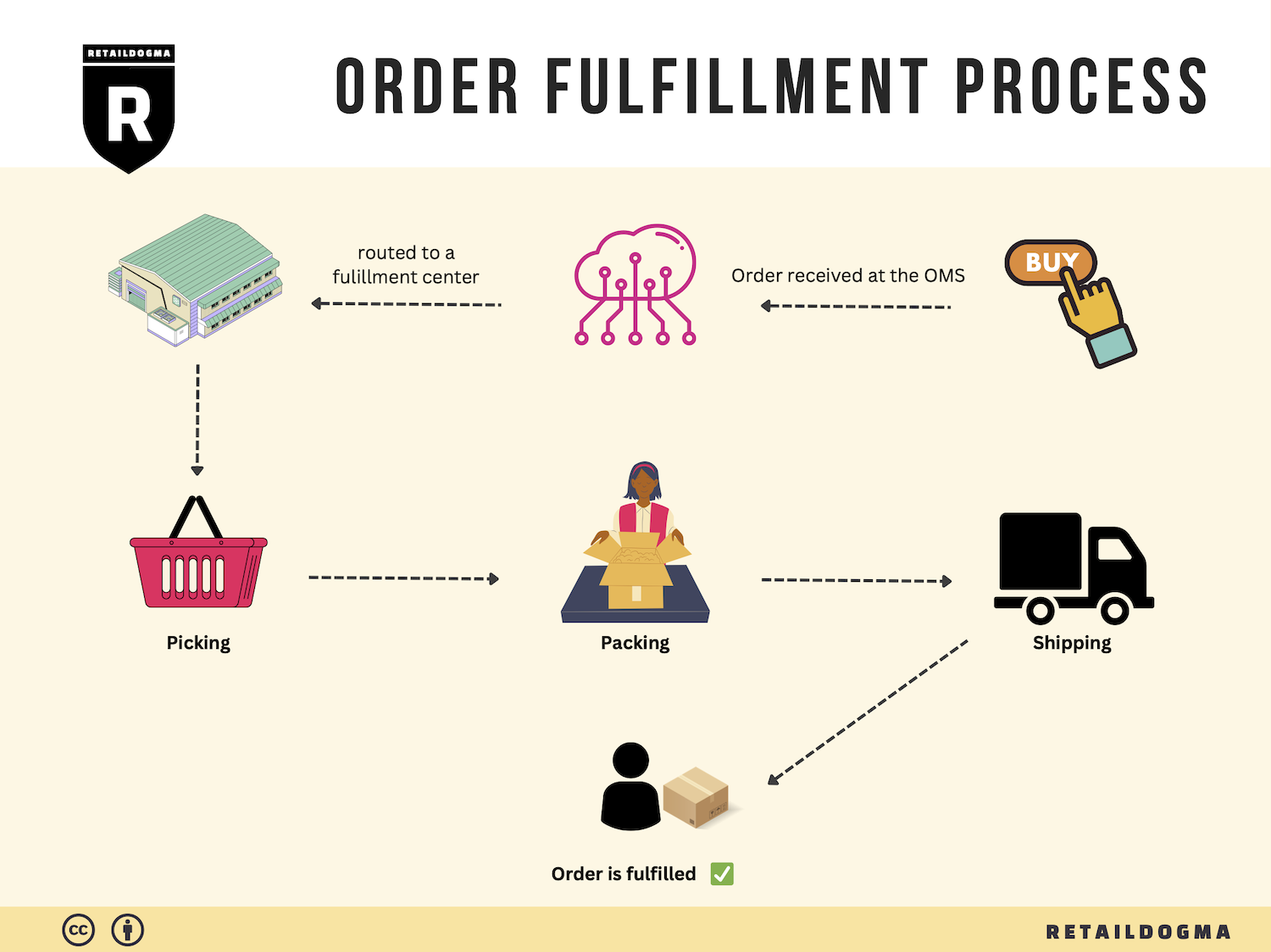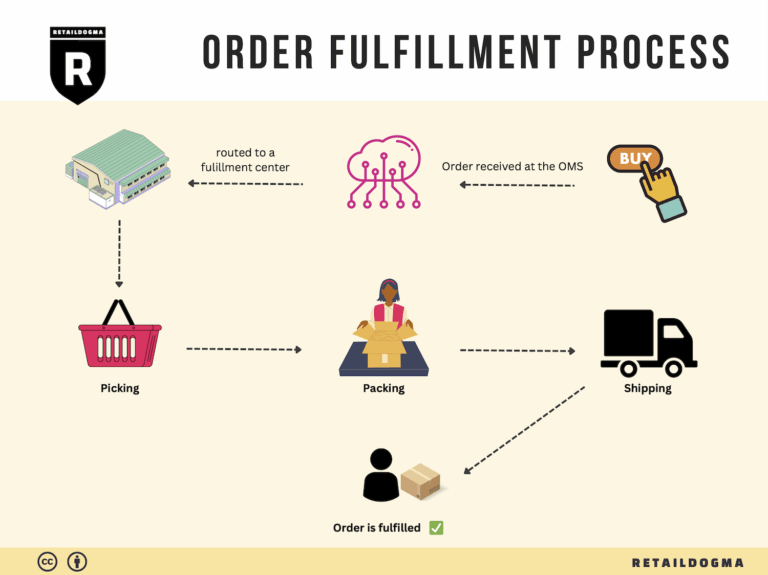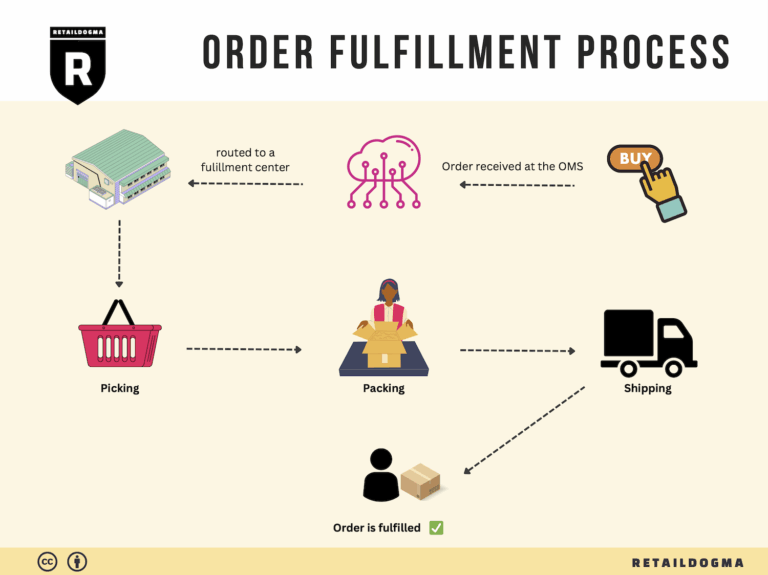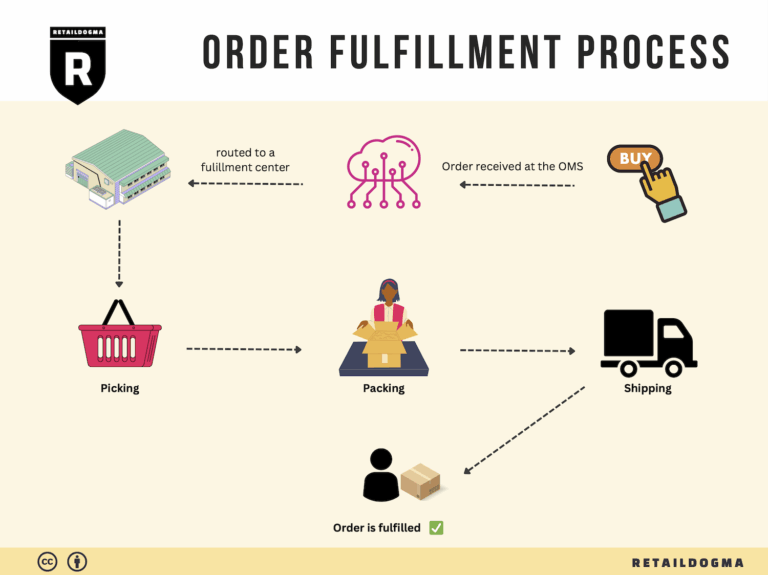Ecommerce Fulfillment Services: The Ultimate Guide (2025)
What is E-commerce Fulfillment? An Introduction for Growing Businesses
Navigating the Complexities of E-commerce Fulfillment
As your online business begins to grow, the initial excitement of expanding your sales can quickly be overshadowed by the logistics of packing and shipping orders. Many entrepreneurs find themselves overwhelmed by the complexities of fulfillment, struggling to manage inventory, handle returns, and ensure timely deliveries. This is where understanding e-commerce fulfillment becomes crucial.
E-commerce fulfillment is the process of getting a product from your online store to your customer’s doorstep. It encompasses everything from receiving inventory and storing it, to picking, packing, and shipping orders, as well as managing returns. For growing businesses, mastering this process is essential not only for customer satisfaction but also for maintaining operational efficiency.
In this guide, we will explore various fulfillment models available to online retailers, including third-party logistics (3PL) and Fulfillment by Amazon (FBA). Each model comes with its own set of advantages and challenges, and understanding these can help you determine which option best aligns with your business goals.
We will delve into the core services that fulfillment partners typically offer. These include inventory management, order processing, shipping logistics, and returns handling. By grasping what services are available, you can better evaluate potential partners and what they can bring to your business.
Choosing the right fulfillment partner is another critical aspect we will cover. Factors such as location, technology integration, service scalability, and pricing structure play significant roles in making an informed decision. A well-chosen partner can streamline your operations, improve delivery times, and enhance customer satisfaction.
Lastly, we will provide insights into pricing models used by fulfillment providers. Understanding how costs are structured—whether through flat fees, pay-per-order, or storage fees—will empower you to budget effectively and optimize your logistics expenses.
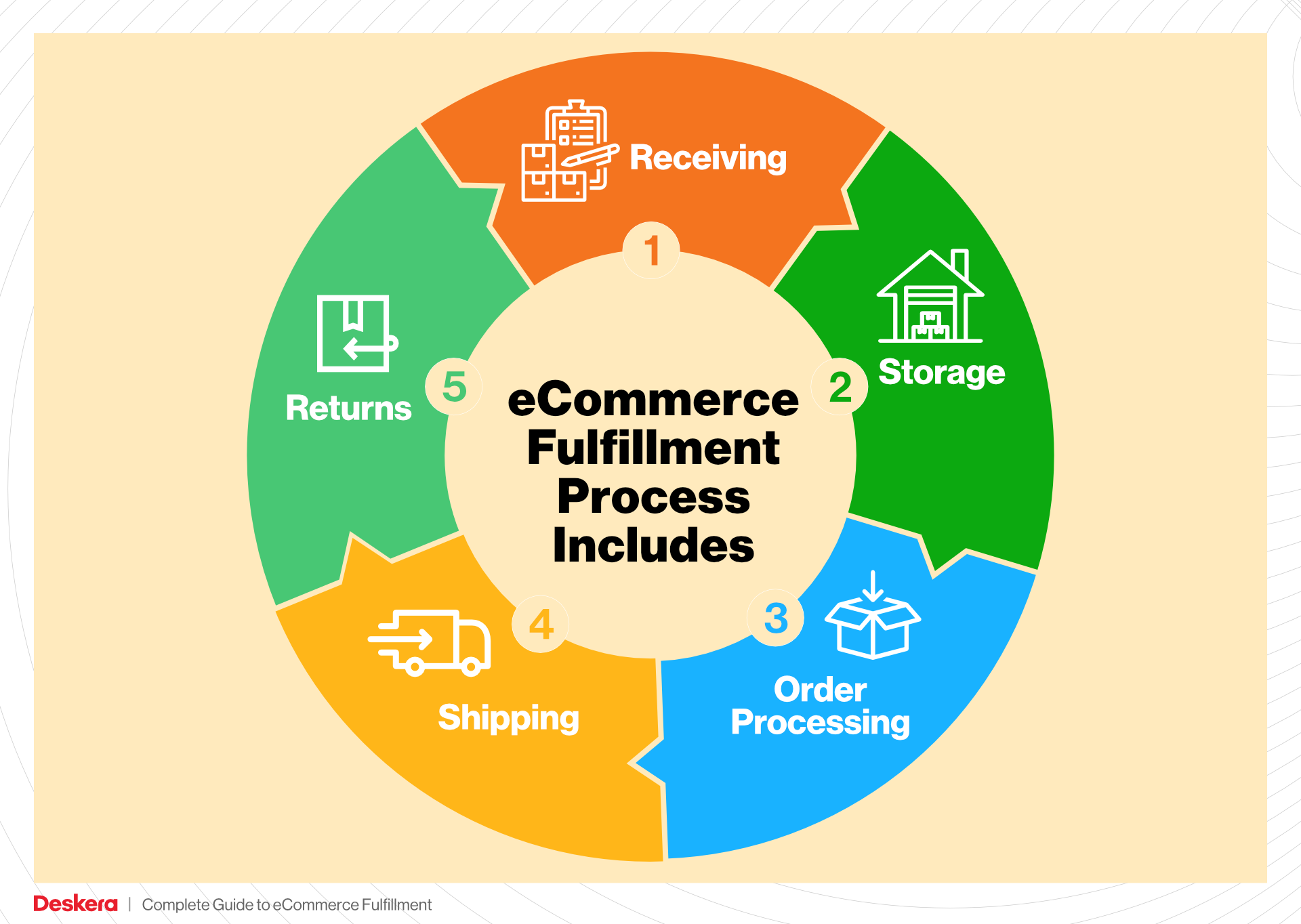
The ultimate goal of this guide is to equip you with the knowledge necessary to make smart decisions about your logistics. By understanding the intricacies of e-commerce fulfillment, you can focus on what you do best: growing your business and delighting your customers.
What You’ll Learn In This Guide
- What is E-commerce Fulfillment? An Introduction for Growing Businesses
- The Order Fulfillment Process: From ‘Buy’ Button to Customer’s Door
- Comparing Fulfillment Models: In-House vs. 3PL vs. Dropshipping
- A Deep Dive into Amazon FBA: Pros, Cons, and Who It’s For
- Core Services Offered by Fulfillment Centers
- How to Choose a Fulfillment Partner: A 6-Point Checklist
- Understanding Fulfillment Pricing: A Breakdown of Common Fees
- Frequently Asked Questions (FAQs) about Fulfillment
- Conclusion: Is Outsourcing Fulfillment the Right Move for Your Business?
- Important Disclaimer
The Order Fulfillment Process: From ‘Buy’ Button to Customer’s Door
1. Receiving Inventory
The first step in the order fulfillment process is receiving inventory. This involves accepting shipments from suppliers and ensuring that the correct products have arrived as per the purchase order. During this stage, each item is checked against its SKU (Stock Keeping Unit) to verify accuracy.
Why It’s Important: Effective inventory receiving is crucial for maintaining accurate stock levels. Discrepancies can lead to stockouts or overstock situations, both of which can hinder sales and affect customer satisfaction. Additionally, a smooth receiving process minimizes delays in order processing.
Key Term: SKU (Stock Keeping Unit) – A unique identifier for each distinct product and service that can be purchased. SKUs facilitate efficient inventory tracking and management.
2. Warehouse Storage
Once inventory has been received and verified, the next step is warehouse storage. This process involves organizing products within the warehouse in a way that maximizes space and efficiency. Items are placed in designated storage areas based on their SKU and demand frequency.
Why It’s Important: Proper warehouse storage is essential for quick access to products during the order fulfillment process. By utilizing techniques like ABC analysis (categorizing inventory based on value and turnover rate), businesses can ensure that high-demand items are stored in easily accessible locations, reducing the time taken to fulfill orders.
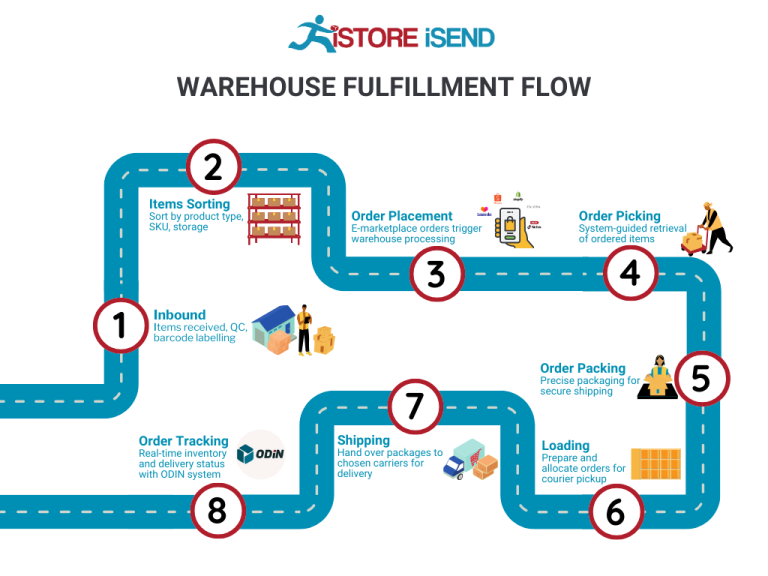
Key Term: Inventory Management System (IMS) – Software that helps manage inventory levels, orders, sales, and deliveries. An IMS aids in tracking stock and optimizing storage.
3. Order Picking
The order picking process begins once a customer places an order. This involves selecting items from the warehouse shelves based on the order details. Pick lists are generated to guide warehouse staff through the most efficient route for retrieving products.
Why It’s Important: Efficient order picking is critical for minimizing delays in order fulfillment. The quicker items are picked, the faster they can be packed and shipped. Implementing technologies like barcode scanners or pick-to-light systems can enhance picking accuracy and speed.
Key Term: Pick List – A document or digital listing of items that need to be collected to fulfill a customer order. It includes product details and quantities, helping streamline the picking process.
4. Order Packing
After items have been picked, the next step is order packing. This involves carefully packaging the products to ensure they arrive safely at the customer’s door. During this process, packing materials are selected based on the nature of the items, and shipping labels are generated.
Why It’s Important: Proper packing is vital for protecting products during transit and minimizing returns due to damage. An organized packing process also helps maintain efficiency, as it can directly impact shipping speed and customer satisfaction.
Key Term: Packing Slip – A document included with the shipment that lists the items contained in the package. It serves as a receipt for the customer and aids in inventory management.

5. Shipping & Delivery
The final step in the order fulfillment process is shipping and delivery. Once orders are packed, they are handed over to shipping carriers for distribution. Tracking information is generated and sent to customers, allowing them to monitor their order’s progress.
Why It’s Important: Timely shipping is crucial for customer satisfaction and retention. Customers expect fast delivery, and any delays can lead to dissatisfaction and negative reviews. Choosing the right shipping partners and methods can significantly impact delivery times and costs.
Key Term: Last Mile Delivery – The final step in the delivery process where the product is transported from a distribution center to the end customer. This phase is often the most complex and costly part of the shipping process.
By understanding and optimizing each of these five steps—receiving inventory, warehouse storage, order picking, order packing, and shipping & delivery—e-commerce businesses can enhance their order fulfillment processes, leading to improved customer satisfaction and business scalability.
Comparing Fulfillment Models: In-House vs. 3PL vs. Dropshipping
Fulfillment Model Comparison
| Model | Who Handles Inventory | Best For (Business Stage) | Key Advantage | Key Disadvantage |
|---|---|---|---|---|
| In-House Fulfillment | The business itself | Established businesses | Complete control over inventory and processes | High fixed costs and labor requirements |
| Third-Party Logistics (3PL) | A third-party provider | Startups to large enterprises | Scalability and flexibility | Less control over operations and inventory |
| Dropshipping | Supplier or manufacturer | New startups and small businesses | Low overhead and no inventory risk | Lower profit margins and longer shipping times |
In-House Fulfillment
In-house fulfillment is a model where businesses manage their own inventory, warehousing, and shipping processes. This approach allows for complete control over every aspect of the fulfillment process, from inventory management to customer service. Companies that opt for in-house fulfillment typically have established operations and sufficient resources to maintain a warehouse and staff.
The key advantage of in-house fulfillment is the ability to customize processes and maintain direct oversight, which can lead to high levels of customer service and brand integrity. Businesses can implement their own technology solutions, optimize picking and packing processes, and directly manage inventory levels. However, this model comes with significant disadvantages, including high fixed costs related to staffing, real estate, and equipment. Additionally, as order volumes fluctuate, businesses may find it challenging to scale operations up or down without incurring additional costs.
Third-Party Logistics (3PL)
Third-party logistics, or 3PL, involves outsourcing fulfillment operations to a specialized logistics provider. This model is particularly beneficial for businesses of all sizes, from startups to established enterprises, as it allows them to focus on their core competencies while the 3PL provider handles warehousing, order processing, shipping, and returns management.
One of the primary advantages of using a 3PL is scalability. Businesses can quickly adjust their logistics capabilities to meet fluctuating demand without the burden of managing a warehouse or workforce directly. Additionally, 3PL providers often have established relationships with carriers, allowing for discounted shipping rates and efficient logistics processes. The downside, however, is that businesses may relinquish some control over their operations and customer experience, as they rely on the 3PL to manage key aspects of their fulfillment. This can lead to potential discrepancies in service quality if the provider does not align with the brand’s standards.
Dropshipping
Dropshipping is a fulfillment model where the retailer does not hold inventory but instead partners with suppliers or manufacturers who ship products directly to the customer. This approach is particularly appealing to new startups and small businesses, as it requires minimal upfront investment and eliminates the risks associated with inventory management.
The main advantage of dropshipping is its low overhead costs; businesses do not need to invest in warehousing or inventory, which significantly reduces financial risk. Additionally, dropshipping allows for a wide product selection without the commitment of purchasing stock upfront. However, this model also presents challenges, such as lower profit margins due to reliance on suppliers and potential delays in shipping times, which can affect customer satisfaction. Furthermore, businesses may have limited control over product quality and fulfillment speed, which can lead to complications in maintaining brand integrity.
Conclusion
Choosing the right fulfillment model is crucial for scaling your e-commerce business. Each model—In-House Fulfillment, Third-Party Logistics, and Dropshipping—has its unique advantages and disadvantages, and the best choice will depend on your business stage, resources, and strategic goals. Businesses must carefully evaluate their operational capabilities, customer expectations, and growth plans to determine which fulfillment approach aligns best with their overall objectives. By understanding these models, you can make informed decisions that facilitate efficient logistics and enhance your customer experience.
A Deep Dive into Amazon FBA: Pros, Cons, and Who It’s For
Understanding Fulfillment by Amazon (FBA)
Fulfillment by Amazon (FBA) is a service provided by Amazon that allows e-commerce sellers to store their products in Amazon’s fulfillment centers. Amazon takes care of storage, packaging, shipping, and customer service on behalf of the sellers. This service enables sellers to leverage Amazon’s vast logistics network, offering customers fast and reliable shipping options, including Amazon Prime.
How FBA Works
-
Setting Up Your FBA Account: To begin using FBA, sellers must create an Amazon Seller account and enroll in the FBA program. This involves providing necessary business information and linking to a payment method.
-
Sending Inventory to Amazon: Once enrolled, sellers prepare their products according to Amazon’s guidelines and ship them to Amazon fulfillment centers. This process includes labeling items with unique barcodes, ensuring they meet Amazon’s packaging and shipping requirements.
-
Storage and Management: After receiving the inventory, Amazon stores it in their warehouses. Sellers can monitor their inventory levels through the Amazon Seller Central dashboard, which provides insights into stock levels, sales metrics, and more.
-
Order Processing: When a customer places an order for a product fulfilled by FBA, Amazon handles the entire process. This includes picking the product from the warehouse, packing it, and shipping it directly to the customer.
-
Customer Service and Returns: Amazon also manages customer service inquiries and handles returns, which simplifies the process for sellers and enhances customer satisfaction.
Pros of Using FBA
1. Prime Eligibility
One of the significant advantages of using FBA is that products become eligible for Amazon Prime. This increases visibility and attracts more customers who value fast shipping. Prime members often prefer to buy products that offer same-day or two-day delivery, leading to higher sales potential.
2. Customer Trust
Products fulfilled by Amazon benefit from the trust and credibility associated with the Amazon brand. Customers are more likely to purchase items that are backed by Amazon’s fulfillment services, knowing they will receive quality service, including reliable shipping and easy returns.
3. Multi-Channel Fulfillment
FBA allows sellers to fulfill orders not only from Amazon but also from other sales channels, such as their own websites or other e-commerce platforms. This multi-channel fulfillment capability streamlines operations, as sellers can manage inventory and shipping from a single location.
4. Scalable Operations
FBA provides a scalable solution for e-commerce businesses. As demand increases, sellers can send more inventory to Amazon without worrying about managing their warehousing or logistics. This flexibility allows businesses to grow without significant upfront investment in infrastructure.
5. Enhanced Seller Support
Amazon provides various resources and tools to help sellers succeed, including analytics, marketing tools, and advertising options. This support can be beneficial for new and growing businesses looking to optimize their sales strategies.
Cons of Using FBA
1. High Fees
One of the most significant drawbacks of FBA is the cost. Sellers incur various fees, including storage fees for keeping inventory in Amazon’s warehouses and fulfillment fees based on the size and weight of the products. These costs can add up quickly, particularly for sellers with lower profit margins.
2. Strict Inventory Rules
Amazon has stringent inventory management policies that sellers must adhere to. This includes guidelines on product preparation, labeling, and storage. Failure to comply with these requirements can result in additional fees or inventory being returned to the seller.
3. Commingling Risks
FBA operates on a commingling model, meaning that products from different sellers may be stored together. This can lead to issues if a customer receives a damaged or defective item that is not from the seller they purchased from. Such situations can affect seller ratings and customer trust.
4. Limited Control Over Fulfillment
While FBA simplifies logistics, it also means sellers have limited control over the fulfillment process. Sellers cannot customize packaging or shipping options, which can be a disadvantage for brands looking to create a unique customer experience.
5. Complicated Returns Process
Although Amazon handles returns, the process can be complicated for sellers. If a returned item is damaged or not in sellable condition, the seller may face challenges in recovering the costs or reselling the item.
Who is FBA Best For?
FBA is particularly suited for:
-
Small to Medium-Sized Businesses: E-commerce entrepreneurs who want to scale quickly without investing heavily in logistics and warehousing can benefit significantly from FBA’s infrastructure and support.
-
Brands with High Sales Volume: Businesses that consistently sell a high volume of products can leverage FBA to manage logistics efficiently and reduce delivery times, enhancing customer satisfaction.
-
Sellers Looking to Expand Reach: For those aiming to reach a broader audience, especially in international markets, FBA’s global fulfillment capabilities can be a game-changer.
-
Businesses with Limited Logistics Experience: New sellers or those without logistics expertise can utilize FBA to simplify order fulfillment and focus on marketing and sales strategies.
In summary, while FBA offers numerous benefits such as increased visibility, customer trust, and operational scalability, it also comes with challenges related to fees, inventory management, and fulfillment control. As with any business decision, sellers should carefully weigh these pros and cons in the context of their specific needs and goals.
Core Services Offered by Fulfillment Centers
Inventory Management & Warehousing
Inventory management and warehousing are foundational services provided by fulfillment centers, ensuring that e-commerce businesses maintain optimal stock levels while minimizing storage costs. This service involves the systematic tracking and management of inventory from the moment it arrives at the warehouse until it is shipped to the customer. Fulfillment centers utilize sophisticated Warehouse Management Systems (WMS) to monitor stock levels, manage incoming shipments, and track product locations within the warehouse.
Benefits:
1. Efficiency: Automated inventory tracking reduces human error and enhances accuracy, ensuring that e-commerce businesses can fulfill orders quickly and reliably.
2. Cost Savings: By outsourcing warehousing, businesses can avoid the high overhead costs associated with owning and maintaining a physical storage facility. Fulfillment centers often offer scalable solutions that grow with your business, allowing you to only pay for the space and services you need.
3. Space Optimization: Fulfillment centers employ efficient storage techniques, allowing them to maximize space and minimize costs. This includes the use of vertical storage, pallet racking, and just-in-time inventory systems.
Pick and Pack Services
Pick and pack services involve the process of selecting products from the warehouse (picking) and preparing them for shipment (packing). When an order is received, fulfillment center staff quickly locate the items in inventory, pack them securely using appropriate materials, and label them for delivery. This process is designed to be fast and efficient, minimizing the time between order receipt and shipment.
Benefits:
1. Speed: Fulfillment centers specialize in rapid order processing, significantly reducing lead times. This allows e-commerce businesses to meet customer expectations for fast shipping, a critical factor in customer satisfaction.
2. Accuracy: The use of barcode scanning and automated systems ensures that the correct items are picked and packed, reducing the likelihood of errors that can lead to returns and dissatisfied customers.
3. Scalability: As your business grows, fulfillment centers can adjust their pick and pack operations to handle increased order volumes without the need for additional investments in labor or technology.
Kitting and Assembly
Kitting and assembly services are particularly valuable for e-commerce businesses that offer products requiring assembly or those that sell bundled items. Kitting involves grouping individual items into a single SKU for easier management and sale, while assembly refers to the process of putting together multiple components to create a final product. Fulfillment centers can handle these tasks, ensuring that products are ready for sale upon delivery to customers.
Benefits:
1. Streamlined Operations: By outsourcing kitting and assembly, businesses can focus on their core operations, such as marketing and product development, rather than labor-intensive assembly processes.
2. Customization: Fulfillment centers can accommodate specific kitting requests, allowing businesses to offer unique product bundles or customized kits that meet customer preferences.
3. Inventory Management: Kitting can help manage inventory more efficiently by reducing the number of SKUs a business has to track, simplifying logistics and improving stock control.
Returns Management (Reverse Logistics)
Returns management, or reverse logistics, is a critical service that fulfillment centers provide, especially in the e-commerce sector where return rates can be significant. This service involves handling the return of products from customers, assessing the condition of returned items, restocking them when appropriate, and managing the associated logistics. Effective returns management is essential for maintaining customer satisfaction and loyalty.
Benefits:
1. Customer Satisfaction: A smooth returns process enhances the customer experience. Fulfillment centers can manage returns efficiently, providing timely refunds or exchanges that meet customer expectations.
2. Cost Control: By managing returns effectively, fulfillment centers help businesses minimize losses associated with returned goods. They can assess whether items can be restocked, refurbished, or need to be disposed of, optimizing inventory levels.
3. Data Insights: Returns management services provide valuable data on customer preferences and product issues, allowing businesses to make informed decisions about inventory, marketing strategies, and product development.
In conclusion, partnering with a fulfillment center offers e-commerce businesses a comprehensive suite of services that enhance operational efficiency, reduce costs, and improve customer satisfaction. By leveraging these core services, businesses can scale their operations effectively and focus on driving sales and growth.
How to Choose a Fulfillment Partner: A 6-Point Checklist
Location & Warehouse Network
Importance: The geographical location of your fulfillment partner’s warehouses can significantly impact shipping times and costs. A strategically located warehouse network ensures faster delivery to your customers, which is crucial for maintaining high satisfaction levels and reducing shipping expenses.
Questions to Ask:
– Where are your warehouses located, and how do they align with my target market?
– What is the average shipping time from your warehouses to major customer locations?
– Do you have plans for expanding your warehouse network in the future?
Technology & Integrations
Importance: In today’s digital landscape, efficient order processing and inventory management rely heavily on technology. A fulfillment partner that offers robust technology solutions can streamline operations, reduce errors, and provide real-time visibility into your inventory.
Questions to Ask:
– What technology platforms do you use for inventory management and order fulfillment?
– Can your systems integrate with my existing e-commerce platforms (like Shopify, WooCommerce, or Amazon)?
– Do you provide an API for seamless data exchange, and how user-friendly is your dashboard for tracking orders and inventory?
Specializations (e.g., cold storage, oversized items)
Importance: Depending on your product type, it’s essential to find a fulfillment partner that has the necessary capabilities to handle your specific needs. Whether you deal with perishables, oversized items, or hazardous materials, the right partner will have the expertise and facilities to manage those products efficiently.
Questions to Ask:
– Do you specialize in handling specific types of products, such as cold storage or oversized items?
– What certifications or compliance measures do you have in place for specialized storage and handling?
– Can you provide case studies or examples of how you have successfully managed similar products for other clients?
Scalability & Capacity
Importance: As your business grows, your fulfillment needs will evolve. A partner with scalable solutions will allow you to adjust your operations without significant disruption, ensuring that you can meet increased demand during peak seasons or business growth phases.
Questions to Ask:
– What is your current capacity for order fulfillment, and how quickly can you scale up if my order volume increases?
– Are there any limitations on the number of SKUs or inventory levels you can handle?
– How do you manage peak seasons, and what plans do you have in place for scaling operations accordingly?
Pricing and Contracts
Importance: Understanding the cost structure and contract terms is vital to ensure that your fulfillment partner aligns with your budget and financial goals. Transparent pricing models can help you avoid unexpected fees and ensure a clear understanding of your total cost of fulfillment.
Questions to Ask:
– Can you provide a detailed breakdown of your pricing structure, including storage fees, order processing costs, and shipping rates?
– Are there any additional charges I should be aware of, such as for returns processing or special handling?
– What are the terms of your contract, and do you offer flexibility for scaling up or down based on my needs?
Customer Support & Reviews
Importance: Exceptional customer support can make a significant difference in your fulfillment experience. A responsive partner will help you quickly resolve issues, while positive reviews from other clients can provide insights into their reliability and performance.
Questions to Ask:
– What customer support channels do you offer (e.g., phone, email, chat), and what are your response times?
– Can you provide references or testimonials from current or past clients?
– How do you handle issues or delays in fulfillment, and what measures do you have in place to ensure consistent service quality?
Conclusion
Choosing the right fulfillment partner is a critical step in scaling your e-commerce business. By considering these six key areas—location and warehouse network, technology and integrations, specializations, scalability, pricing, and customer support—you can make an informed decision that aligns with your business needs. Taking the time to thoroughly evaluate potential partners will not only enhance your operational efficiency but also improve customer satisfaction, ultimately driving your business’s success.
Understanding Fulfillment Pricing: A Breakdown of Common Fees
Initial Setup Fees
When partnering with a fulfillment service, the initial setup fee is often one of the first costs to consider. This fee can cover a range of activities necessary to get your account up and running. Typically, this includes the integration of your e-commerce platform with the fulfillment provider’s systems, data migration, and any initial training required for your team.
Some providers may offer free onboarding as part of a promotional package, while others might charge a one-time fee ranging from a few hundred to several thousand dollars, depending on the complexity of the integration. It’s crucial to inquire upfront about any initial fees and what services they encompass to avoid unexpected costs later.
Receiving Fees
Receiving fees are charged when your inventory arrives at the fulfillment center. These fees cover the labor and resources needed to unload, inspect, and store your products.
The calculation of receiving fees can vary based on several factors, including:
– Volume of Inventory: Larger shipments might incur a lower per-unit cost due to economies of scale.
– Type of Products: Special handling requirements for fragile or oversized items can increase costs.
– Condition of Goods: If products require additional inspection or repackaging, this may also result in higher fees.
Typically, receiving fees can range from $0.10 to $0.50 per unit, but it’s advisable to clarify these charges with your provider to understand their specific structure.
Storage Fees (per pallet/bin)
Storage fees are incurred for keeping your inventory at the fulfillment center. These fees are usually calculated on a per-pallet or per-cubic-meter basis, and they can vary significantly based on the location and demand for space in the warehouse.
Factors influencing storage fees include:
– Location: Warehouses in high-demand areas may charge higher storage fees.
– Volume: The total cubic space your inventory occupies will determine the overall storage cost. Many fulfillment centers charge monthly fees, which can range from $10 to $30 per pallet or $5 to $20 per cubic meter.
It’s essential to monitor your inventory levels closely, as excess stock can lead to increased storage fees. Additionally, inquire if there are any discounts for long-term storage or for storing larger quantities.
Pick & Pack Fees (per item/order)
Pick and pack fees are charged for the labor involved in retrieving products from storage and packaging them for shipment. This fee is typically calculated per order or per item, depending on the fulfillment provider’s pricing model.
Key considerations in pick and pack fees include:
– Order Complexity: More complex orders, such as those requiring multiple items or special packaging, may incur higher fees.
– Volume Discounts: Many providers offer lower per-order fees as your order volume increases. For example, you might see charges ranging from $1.00 to $3.00 per order, or $0.50 to $1.50 per item.
Understanding the pick and pack process and how your specific needs impact these fees is crucial for budgeting accurately.
Shipping Fees
Shipping fees are often one of the largest costs associated with fulfillment services. These fees cover the transportation of your products to customers and can vary based on several factors:
- Destination: Shipping to remote areas may cost more than shipping to urban centers.
- Weight and Dimensions: Heavier or larger packages typically incur higher shipping fees.
- Shipping Method: Options like standard, expedited, or overnight shipping can significantly affect costs.
Fulfillment providers typically negotiate bulk shipping rates with carriers, which can be passed on to you. It’s wise to discuss shipping options and any potential savings from volume shipping arrangements with your provider.
Tips for Getting an Accurate Quote
To ensure you receive an accurate fulfillment pricing quote, consider the following tips:
-
Be Transparent: Provide a clear overview of your inventory, order volume, and specific needs. The more information you share, the more accurate the quote will be.
-
Ask About All Fees: Ensure you understand all potential fees, including hidden or ancillary charges that may arise.
-
Request Comparisons: If possible, get quotes from multiple providers to compare pricing structures and services.
-
Evaluate Scalability: Discuss how the pricing might change as your business grows, ensuring you understand the implications of increased volume on costs.
-
Review Contracts Carefully: Before committing, read the contract thoroughly to identify any terms that may affect pricing over time.
By understanding these common fulfillment fees and asking the right questions, you can make informed decisions that align with your business growth strategies.
Frequently Asked Questions (FAQs) about Fulfillment
1. What is an Amazon Flex Fulfillment Center?
An Amazon Flex Fulfillment Center is a logistics facility where Amazon manages the storage, processing, and shipping of products for sellers using its platform. These centers enable sellers to store their inventory closer to customers, facilitating faster delivery and improved customer satisfaction.
2. What is the difference between a warehouse and a fulfillment center?
While both warehouses and fulfillment centers are used for storage, a fulfillment center focuses on order processing and shipping to end customers. Fulfillment centers are designed for high-volume order fulfillment, including picking, packing, and shipping, whereas warehouses typically prioritize long-term storage.
3. What is a Third-Party Logistics Provider (3PL)?
A Third-Party Logistics Provider (3PL) is a company that offers outsourced logistics services, including warehousing, inventory management, order fulfillment, and shipping. By partnering with a 3PL, e-commerce businesses can scale their operations without the overhead costs associated with managing their own logistics.
4. How do I integrate my e-commerce store with Amazon Flex Fulfillment?
Integrating your e-commerce store with Amazon Flex Fulfillment involves connecting your store’s platform—such as Shopify or WooCommerce—to the fulfillment service. Most providers offer API integrations that allow seamless synchronization of inventory and order processing.
5. What are the typical costs associated with fulfillment services?
Fulfillment service costs vary based on several factors, including order volume, storage space, and specific services required. Common fees include storage fees (charged per cubic meter), order processing fees (charged per order), and shipping costs. It’s advisable to request a detailed quote from the fulfillment provider to understand all potential costs.
6. How can fulfillment services help scale my e-commerce business?
Fulfillment services can significantly enhance scalability by handling the logistics of storage, order processing, and shipping. This allows business owners to focus on growth strategies such as marketing and product development rather than day-to-day logistics, enabling them to scale operations quickly and efficiently.
7. What is the process for handling returns in a fulfillment center?
Fulfillment centers typically have a dedicated returns process that includes receiving returned items, inspecting them, restocking, or processing them for disposal if necessary. Many providers also offer automated return management systems to streamline the process for both sellers and customers.
8. How does Amazon Flex Fulfillment ensure timely delivery?
Amazon Flex Fulfillment utilizes strategically located centers to minimize shipping distances and leverage Amazon’s extensive logistics network. This includes partnerships with local carriers and sophisticated tracking systems to monitor the status of shipments in real time, ensuring timely delivery to customers.
9. What are the benefits of using Amazon Flex Fulfillment over self-fulfillment?
Using Amazon Flex Fulfillment provides several advantages over self-fulfillment, including reduced operational overhead, access to advanced logistics technology, scalable solutions for growing businesses, and the ability to offer faster shipping options, which can enhance customer satisfaction and loyalty.
10. Can I use Amazon Flex Fulfillment for international shipping?
Yes, Amazon Flex Fulfillment can support international shipping, allowing sellers to reach customers across various countries. However, it’s essential to understand the specific regulations, costs, and logistics involved in shipping to different regions, as these can vary significantly based on the destination.
Conclusion: Is Outsourcing Fulfillment the Right Move for Your Business?
Evaluating the Benefits of Outsourcing Fulfillment
Outsourcing fulfillment can be a transformative decision for e-commerce businesses looking to scale efficiently. One of the most significant advantages is time savings. By partnering with a fulfillment service, you can redirect your focus from the logistical complexities of order processing to core business activities such as sales and marketing. This shift allows you to concentrate on growth strategies that drive revenue rather than getting bogged down in day-to-day operational tasks.
Moreover, scalability is a critical factor. As your sales volume fluctuates, an experienced fulfillment partner can adapt to your needs without the burden of increasing overhead costs associated with maintaining your own warehouse. This flexibility is particularly beneficial during peak seasons or promotional events, ensuring that you can meet customer demand without compromising service quality.
Additionally, leveraging the expertise of a fulfillment service can lead to improved operational efficiencies. These providers specialize in logistics and are adept at managing inventory, processing returns, and optimizing shipping routes. Their experience in the field can help you navigate common pitfalls, such as shipping delays or inventory mismanagement, ultimately enhancing customer satisfaction.
However, it is essential to choose the right fulfillment partner for your business. Not all providers offer the same level of service, and aligning your needs with their capabilities is crucial for sustained growth.
Call to Action
To determine if outsourcing fulfillment is the right move for your business, consider conducting an audit of your current shipping processes. Assess your operational costs, delivery times, and customer feedback. This analysis will provide you with a clearer picture of whether a fulfillment partner can help you enhance efficiency and scale your operations effectively. Don’t hesitate to explore your options; a strategic partnership could be the key to unlocking your business’s potential.
Important Disclaimer
⚠️ Important Disclaimer
The information in this guide is for educational purposes. Fulfillment services, pricing, and platform features change frequently. Always conduct your own due diligence and consult with providers directly before making business decisions.
